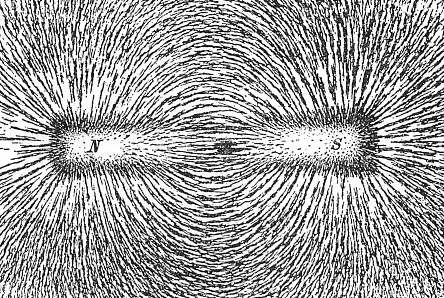To properly assess the merits of the scientific literature regarding electromagnetic fields and radiation, one must first come to some basic understanding of the underlying physics. This page is intended to provide the necessary background that will enable the reader to speak and read more fluently the language of this scientific field.
The Electromagnetic Field
Colloquially, we speak of an electromagnetic field as if you could point to this EMF or that EMF. This is an unfortunate choice of language. In reality, there is one single universal electromagnetic field. Thus, we should refer to it as the electromagnetic field. The electromagnetic field is not just a mathematical construct; it is a physical entity that fills all of space and time.
Maxwell's equations are generally considered to be the primary governing equations of electromagnetism. The electromagnetic field represents the solution to these four equations. The ultimate solution to Maxwell's equations takes into account all of the electric charges and currents in the universe and extends through the infinity of space and time. This is what is meant by the electromagnetic field.
In most cases, it is not feasible to solve for the electromagnetic field, but we can still solve Maxwell's equations for a smaller system (i.e., not the entire universe) by imposing boundary conditions. These boundary conditions are an approximation of the universe and generally give us good solutions for small systems (e.g., a simple capacitor in a circuit board). This is what is meant by an electromagnetic field. In other words, an electromagnetic field is the simplified version of the universal electromagnetic field for the small system that we are considering (like a 5G smartphone). Looking at an electromagnetic field is a good way to evaluate the small system without having to know the location of every electric charge and current throughout the entire universe.
There is nothing inherently dangerous about the electromagnetic field. It is simply the magnetic field and electric field put together. Grab a balloon and rub it in your hair. While you're doing that, take a magnet and start waving it around your body. These simple actions are changing the electromagnetic field via the individual electric and magnetic fields. The only danger here is if you do this exercise in public without explanation, something we suggest should be avoided.

Electromagnetic Waves (Radiation)
Electromagnetic waves are simply "traveling ripples" in the electromagnetic field. These waves are also referred to as electromagnetic radiation (EMR) or "light" which includes both visible and non-visible light. All of these terms are completely synonymous and interchangeable. Unlike the electromagnetic field, it is actually coherent to refer to this electromagnetic wave or that electromagnetic wave just as it makes sense to differentiate between two waves in the ocean. The anatomy and behavior of a wave is crucial to our physical intuition here. As with all waves, electromagnetic waves haves peaks and troughs, they oscillate up and down, and they travel from one location to another while carrying energy and momentum. To classify waves, we naturally use the frequency and wavelength. We can also refer to the amplitude (the height) of the wave.
Imagine being at the beach, watching the waves roll in. You see waves crashing in two different locations. On the one hand, you observe waves with a small amplitude (these are only a few inches tall), and they reach shore once every 10 seconds on average. This corresponds to a frequency of 0.1 Hz (pronounced "hertz"; you may read this as "per second" as in "one-tenth of the wave reaches shore per second"). Finally, you notice that the separation from the peak of the wave to its next peak is 20 feet (although we almost exclusively use meters in physics), so the wavelength is 20 feet. All of this is hopefully very intuitive. Now we turn our gaze to the other wave. This one has an amplitude of 50 feet. Its frequency is 10 Hz (as in, 10 of these waves crash on the shore in the exact same location per second, something that is not physically realistic but useful for our purposes here) and its wavelength is, say, 5 feet (as in, 5 feet separate one peak from the next as these monstrous waves come rolling in at incredible speed).

If you were asked to choose which location to go sunbathe at, you will assuredly pick the former. Thus, we see that some waves are more dangerous than others. Although the wave itself is NOT inherently dangerous, certain combinations of wavelength, frequency, and amplitude ARE dangerous. The same is true for electromagnetic waves.
The Difficulty of Conceptualizing the Problem
All visible light is just a slice out of the full spectrum of electromagnetic waves. When you perceive the color purple, electromagnetic waves are entering the eye, stimulating the S-cone receptors at a frequency of $7.5\cdot10^{14}$ Hz (as in, 750 trillion waves per second). And this is where the breakdown occurs in how the public understand electromagnetic radiation. The magnitudes we are dealing with here are enormous — 750 trillion waves per second, and that doesn't even account for the countless waves entering your eye from all of the other cumulative sources around you. Furthermore, what if you turn around, and the purple object is no longer in your view? Does your body stop receiving that dose of radiation? Of course not! Those waves continue to emanate from the object regardless of whether or not you are looking at it.
I repeat again: this is where the breakdown occurs. If electromagnetic radiation from the visible light spectrum is this difficult to comprehend intuitively, how can we possibly hope to comprehend all of the invisible electromagnetic radiation? As just one example, a dental x-ray might have a frequency of $1\cdot10^{19}$ Hz. Whereas our purple radiation had a frequency of 750 trillion Hz, this x-ray radiation is something like 10 million trillion Hz! This is the difference between the two ocean waves discussed above, now in terms of electromagnetic waves.
The Electromagnetic Spectrum
The electromagnetic spectrum includes all of the possible "ripples" in the electromagnetic field; it runs the gamut of frequencies and wavelengths. It's important to understand that all of the various categories of electromagnetic radiation are, scientifically, light. These terms are used interchangeably and have no difference in fundamental, physical meaning.
Electromagnetic waves are a special kind of wave because the frequency and wavelength are linked together as a consequence of the fact that all electromagnetic waves travel at the speed of light (roughly $3\cdot10^8$ meters per second). The general formula to convert between frequency and wavelength is: $$f=v/\lambda$$ where $v$ is the speed of the wave, $f$ is the frequency, and $\lambda$ is the wavelength. However, for electromagnetic waves, the only possible speed is the speed of light, usually denoted as $c$, so the formula becomes $$f=c/\lambda$$
Although this equation looks exactly the same as the previous one, a subtle change has occurred. By fixing the speed, we have made it so that each frequency is inextricably mapped to a distinct wavelength. With an ocean wave, because the speed is not set, one has to give both the frequency and wavelength to describe the wave. For electromagnetic waves, either the frequency or the wavelength will suffice to describe the wave. The other can simply be calculated since the value of $c$ is known.
Conclusion
For now, these definitions will suffice to give the reader a practical introduction to the proper use of the terms discussed above. We encourage the reader to use this knowledge as a litmus test to determine the credibility of sources that discuss the biological and environmental impact of electromagnetic phenomena. If the proper physical understanding is missing, then perhaps the claims of such a source represent a house of cards built on a sandy foundation. Proceed, then, with caution and a healthy dose of skepticism.

